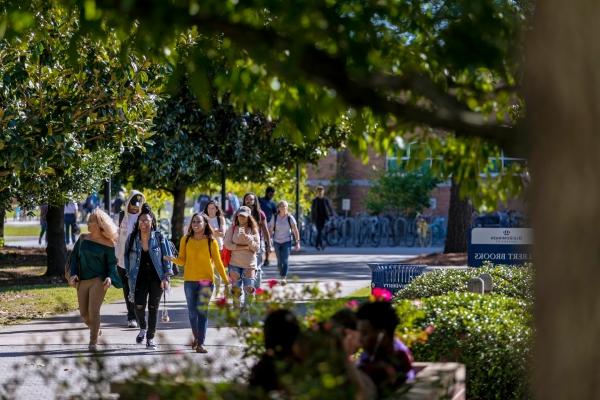Sexual assault, dating violence, and domestic violence can happen to anyone. 2019年美国大学协会的一项调查显示 on sexual assault and misconduct polled over 150,000 students at 27 universities. The data revealed 13% of the students had been impacted by some form of nonconsensual sexual assault.
妇女中心提供资源, advocacy, 为所有性别的学生提供服务, gender identities, 包括男性和变性人. 我们和所有种族的幸存者一起工作, religions, incomes, languages, abilities, ethnicities, and sexual orientations. However, 我们认识到,有一些社区受到性侵犯/人际暴力的不成比例或不同程度的影响,他们无法获得服务.
The Women's Center is committed to serving all students by providing accessible, free, culturally competent, and confidential advocacy and services to all survivors and their allies.
下面是社区的起始列表. 这不是一个详尽的清单. 我们的目标是继续建立联系,并帮助学生理解每个人都值得支持, 妇女中心在这里提供帮助:
Servicing Active Military & Student Veterans
军人性创伤(MST)是退伍军人事务部(VA)用来指退伍军人在军队期间发生的性侵犯或多次威胁性性骚扰的术语. 它包括任何违背某人意愿的性行为——他们可能是被迫进行性行为的(例如), 以拒绝性合作的负面后果为威胁,或暗示以更快的晋升或更好的待遇作为性交易的交换), 可能无法同意性行为(例如, when intoxicated), 或者可能是被强迫进行性行为.
人际暴力(跟踪)的影响, relationship abuse, and sexual violence) effects all people regardless of their identity.
When sexual assault occurs it is devastating to the victim regardless of sex and/or gender. 根据法律,所有受害者,无论男女,都享有同样的权利. Survivors of sexual violence often blame themselves for the attack(s). Men, in particular, may feel that they should have been strong enough to defend themselves against the assault. 其他人可能会觉得如果他们不说“不”是他们的错。.
Here at ODU, 我们有一群人,包括现役军人和退伍军人学生,他们有独特的需求,并且处理了许多平民学生从未处理过的事情. 妇女中心认识到这些差异,并致力于为退伍军人和与军方有关的学生提供无障碍的服务, free, culturally competent, 并为所有幸存者及其盟友提供保密支持.
Concerns
All survivors that use the Women's Center's services have the right to respectful treatment.
如果你在服役期间或回到平民生活时经历过性创伤,妇女中心可以帮助你确定并联系到校园内外的服务和办公室,这些服务和办公室可以最好地帮助你解决你的独特情况.
服务国际学生
在美国的国际学生人数.S. 自20世纪70年代初以来翻了两番,达到近80万人. Similarly, at ODU there has been a significant change in the international student body over the past several years. International students may experience adjustment difficulties due to:
- Language
- 阻碍与美国进行有意义互动的文化障碍.S. students
- Lack of support network
- 高学术期望带来的压力
- 缺乏财政资源
These factors could lead to an increased potential of being victimized. For example, 当国际学生被问及是否愿意看“Netflix和放松”时,同意的概念可能会被利用。. 这是性的暗号(委婉).
Concerns:
- 强烈的忠诚与种族、文化、国籍和家庭紧密相连.
- 文化和/或宗教信仰限制幸存者离开虐待关系或涉及外人.
- Distrust of law enforcement, the criminal justice system, and social services.
- Lack of service providers that look like the survivor or share common experiences.
- 缺乏与文化和语言相适应的服务.
- Lack of trust based on a history of racism and classism in the United States
- Fear that their experience will reflect on or confirm the stereotypes placed on their nationality.
- 提供者基于种族或国籍的假设.
- 对普遍存在的暴力和/或妇女在本国受到的待遇的态度和陈规定型观念.
- Legal status in the U.S. 幸存者和/或行凶者的照片.
我们认识到,任何这些担忧都可能阻止国际学生寻求帮助. However, 妇女中心致力于提供无障碍, free, culturally competent, 并为所有国际学生提供保密服务.
Serving LGBTQIA students
包括跟踪在内的性暴力的影响, domestic violence, 关系虐待会影响所有人,无论他们的身份如何. However, LGBTQIA people have several special considerations when coping with relationship abuse, sexual assault, and stalking. In fact, it is estimated that between 25 and 33 percent of LGBTQIA relationships include abuse, 这一比率与异性恋和异性恋关系的比率相等. 有一种误解认为,如果在LGBTQIA关系中发生暴力,那一定是相互争斗,而且不像在异性恋关系中那样反映出权力和控制问题.
妇女中心认识到这些差异,并致力于为LGBTQIA人群提供无障碍服务, free, culturally competent, and confidential advocacy and direct services to all survivors and their allies. The Women's Center works in collaboration with the Safe Space Committee to work help reduce homophobia, transphobia, 以及最靠谱的网赌软件社区的异性恋现象.
Statistics
亲密伴侣暴力可能发生在任何人身上. According to the 2010 National Intimate Partner and Sexual Violence Survey, “与异性恋女性相比,双性恋女性一生中遭受亲密伴侣强奸和其他性暴力的几率明显更高”,“一生中遭受强奸的几率也明显更高”, physical violence, and/or stalking by an intimate partner when compared to lesbian and heterosexual women."
Some studies indicate that between 20 and 35 percent of LGBTQIA couples experience domestic violence.
根据另一项研究, 在接受调查的跨性别者中,有50%的人在出柜后曾被主要伴侣打过. LGBTQIA青年报告约会暴力发生率为30%, 相比之下,异性恋学生的比例为9%.
M.L. Walters, J. Chen, and M.J. Breiding, 2013, 全国亲密伴侣和性暴力调查:2010年性取向受害者调查结果, Atlanta, GA:国家伤害预防与控制中心, 疾病控制和预防中心, 18-20, accessed Dec. 13, 2013
Concerns
虽然LGBTQIA关系虐待的许多方面与异性恋受害者的经历相似, 它并不完全相同. Perpetrators often attempt highly specific forms of abuse based on identity and community dynamics, some of which include:
- "Outing" or threatening to out a partner's sexual orientation or gender identity to family, friends, employers, 或者在其他情况下,这种披露可能构成威胁.
- Telling the survivor that abusive behavior is a "normal" part of LGBTQIA relationships, or that it cannot be relationship violence because it is occurring between LGBTQIA individuals.
- 操纵朋友和家人的支持,以及产生同情和信任,以切断幸存者的这些资源.
- 把暴力描述成相互的,甚至是两厢情愿的, 尤其是当伴侣试图抵抗的时候, 或者作为一种男子气概或其他一些“可取的”特征的表达.
- 干扰他们的伴侣在变性过程中摄入的荷尔蒙, 或者强迫他们的伴侣变性, interfering with insurance, 或医疗服务提供者的访问/预约.
- Pressure not to report violence to avoid bringing increased stigma or conflict to the community.
Serving male students
人际暴力(跟踪)的影响, relationship abuse, and sexual violence) effects all people regardless of their identity.
When sexual assault occurs it is devastating to the victim regardless of sex and/or gender. 根据法律,男性受害者享有与女性相同的权利. Men are entitled to the same services and support following a sexual assault. Survivors of sexual violence often blame themselves for the attack(s). Men, in particular, may feel that they should have been strong enough to defend themselves against the assault. They may feel that a "real man" could have avoided the sexual assault. It is important to help victims understand that they are not to blame. 性暴力是一种权力和控制犯罪,犯罪者使用许多方法来控制受害者, including fear, shame, threats, 以及酒精和毒品等使人衰弱的物质. The Women's Center recognizes these differences and is committed to male victims by providing accessible, free, culturally competent, 并为所有幸存者及其盟友提供保密支持.
Statistics
一项2005年由美国农业部进行的研究表明.S. 疾病控制中心, 圣地亚哥凯撒医疗机构的HMO会员, 报告称,16%的男性在18岁之前遭受过性虐待.
2003年,一项针对美国的全国性调查显示.S. adults reported that 14.2%的男性在18岁之前遭受过性虐待.
A 1998 study reviewing research on male childhood sexual abuse concluded that the problems are "common, under-reported, under-recognized, and under-treated."
1996年,一项针对波士顿地区男大学生的研究报告称,18%的男性在16岁之前遭受过性虐待.
尽管这些数据令人担忧, 值得注意的是,这些数据可能并未显示出问题的全部范围,因为男性报告暴力的可能性低于女性.
Concerns
男性受害者在举报犯罪和获得他们需要和应得的医疗援助和情感支持方面可能面临独特的障碍. 男性性侵幸存者可能会相信警方, medical professionals, 甚至性侵犯支持中心的倡导者也会对他们的经历麻木不仁,因为他们是男性.
男性强奸受害者遭受和感受到与女性强奸受害者相似的恐惧——人们会相信他们可能很享受被强奸的神话. Some men may believe they were not raped or that they gave consent because they became sexually aroused, had an erection, 或者在性侵过程中射精了. 这些都是正常的、不由自主的生理反应. It does not mean that the survivor wanted to be raped or sexually assaulted, 或者幸存者很享受这段创伤经历. 性唤起并不一定意味着双方同意.
There are many reasons that male victims do not come forward and report being raped, but perhaps the biggest reason for many males is the fear of being perceived as homosexual. However, male sexual assault has nothing to do with the sexual orientation of the attacker or the victim, 就像性侵犯不会让受害者/幸存者变成同性恋一样, bisexual or heterosexual. It is a violent crime that affects heterosexual men as much as LGBTQ+ men.
ODU Counseling Services and the YWCA provides counseling and support services for men.
Serving students of Color
人际暴力(跟踪)的影响, relationship abuse, and sexual violence) effects all people regardless of their identity. However, 有色人种幸存者往往面临着缺乏与文化或种族相适应的服务以及多种语言的支持性资源的问题.
The Women's Center provides advocacy, services and programs for everyone.
有色人种过去可能经历过种族主义, and this may cause them to distrust the institutions that are designed to help survivors. 在医院或警察局, 与白人相比,有色人种可能受到更少的尊重或优先权,在相同的机构中,有色人种可能比白人面临更多的受害者指责和怀疑.
妇女中心认识到这一动态,并致力于为有色人种幸存者提供无障碍服务, free, culturally competent, and confidential advocacy and direct services to all survivors and their allies.
Concerns
Each community of color has challenges and circumstances that are unique to its community. However, there are common factors that account for many of the barriers survivors of color face as they seek help.
- 文化和/或宗教信仰限制幸存者离开虐待关系或涉及外人.
- 强烈的忠诚与种族、文化和家庭紧密相连.
- Distrust of law enforcement, the criminal justice system, and social services.
- Lack of service providers that look like the survivor or share common experiences.
- 缺乏与文化和语言相适应的服务.
- Lack of trust based on a history of racism and classism in the United States.
- Fear that their experience will reflect on or confirm the stereotypes placed on their ethnicity.
- 基于种族的提供者假设.
- 对有色人种社区普遍存在的家庭暴力和性侵犯的态度和刻板印象.
- Legal status in the U.S. 幸存者和/或行凶者的照片.
Statistics
非裔美国女性遭受亲密伴侣暴力的比例比白人女性高35%, and about 2.是其他种族女性的5倍, however, 她们比白人妇女更不可能使用社会服务, battered women's programs, 或者因为家庭暴力而去医院.
Source: Women of Color and Reproductive Justice: African American Women
In a study conducted by the Asian Task Force against Domestic Violence, 47% of Cambodians interviewed said they knew of a woman who experienced domestic violence.
According to NVAWS, 37.5%的美洲原住民女性一生中都是IPV的受害者, defined by rape, physical assault, or stalking.
资料来源:2006年全国侵害妇女犯罪调查
在一项研究中,48%的拉丁裔人报告说,自从他们移民到美国以来,他们的伴侣对他们的暴力行为有所增加.
Source: Dutton, Mary; Leslye Orloff, and Giselle Aguilar Hass. 2000, 寻求帮助行为的特征, resources, and services needs of battered immigrant Latinas: Legal and Policy Implications. 乔治城贫困法律与政策杂志. 7(2)








